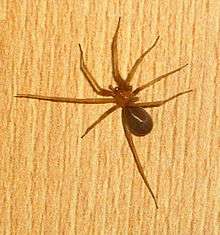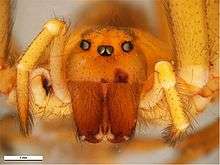Chilean recluse spider
The Chilean recluse spider is a highly venomous spider, Loxosceles laeta, of the family Sicariidae (formerly of the family Loxoscelidae). In Spanish, it (and other South American recluse spiders) is known as araña de rincón, or "corner spider"; in Portuguese, as aranha-marrom or "brown spider". This spider is considered amongst the most dangerous of the recluse spiders, and its bite if untreated may eventually lead to severe systemic reactions in a few exceptional cases, including death.
| Chilean recluse spider | |
|---|---|
 | |
| Scientific classification | |
| Kingdom: | Animalia |
| Phylum: | Arthropoda |
| Subphylum: | Chelicerata |
| Class: | Arachnida |
| Order: | Araneae |
| Infraorder: | Araneomorphae |
| Family: | Sicariidae |
| Genus: | Loxosceles |
| Species: | L. laeta |
| Binomial name | |
| Loxosceles laeta (Nicolet, 1849)[1] | |
| Synonyms[1] | |
| |
.jpg)
Description
The Chilean recluse is one of the larger species of recluse spiders, generally ranging from 8–40 mm in size (including legs). Like most recluses, it is brown and usually has markings on the dorsal side of its thorax, with a black line coming from it that looks like a violin with the neck of the violin pointing to the rear of the spider resulting in the nickname "fiddleback spider" or "violin spider" in English-speaking areas. Coloring varies from light tan to brown and the violin marking may not be visible. Since the "violin pattern" is not diagnostic, it is far more important, for purposes of identification, to examine the eyes. Most spiders have eight eyes, but recluse spiders have six eyes arranged in pairs (dyads) with one median pair and two lateral pairs.
Like other recluse spiders, the Chilean recluse builds irregular webs that frequently include a shelter consisting of disorderly threads. Unlike most web weavers, they leave these webs at night to hunt. People get bitten when they unintentionally squeeze them in clothing and bedding. These spiders frequently build their webs in woodpiles and sheds, closets, garages, and other places that are dry and generally undisturbed. The spider is frequently found in human dwellings. The spiders can last a long time without food or water,[2] a fact that encourages their worldwide spread.
Habitat
The Chilean recluse spider is native to South America. It is common in Chile, and can be found in Perú, Ecuador, Argentina, Uruguay, and south and eastern Brazil.[3][4]
It has been introduced into several areas outside its natural range but does not thrive in those locations. The spider is known to have established itself in the Los Angeles area.[5] Infestations have been reported in the United States (Massachusetts, Florida, Kansas[6]), Canada (Vancouver, British Columbia), and Australia. One colony of the spider is living in the Natural History Museum of Helsinki where it was probably introduced through fruit shipments in the 1960s and 1970s.[7][8] Local daycares, preschools and schools arrange daytrips here and parents are forewarned about the risk by required consent forms, although only one bite has ever been recorded.
Medical significance

As indicated by its name, this spider is not aggressive and usually bites only when pressed against human skin, such as when putting on an article of clothing. Like all sicariid spiders, the venom of the Chilean recluse contains the dermonecrotic agent Sphingomyelinase D, which is otherwise found only in a few pathogenic bacteria. According to one study, the venom of the Chilean recluse along with the six-eyed sand spider Hexophthalma hahni, contains an order of magnitude more of this substance than that of other sicariid spiders such as the brown recluse.[9] For a comparison of the toxicity of several kinds of spider bites, see the list of spiders having medically significant venom.
Spectrum of disease
Disease may range from a minor bite with mild skin irritation, to severe skin necrosis, called cutaneous loxoscelism, to a less common syndrome in 10-15% of cases, a systemic illness called viscerocutaneous loxoscelism, because it involves inner organs. Cutaneous loxoscelism results from serious bites causing a necrotising skin ulcer in about 50% of bites[10] with destruction of soft tissue and may take months, and rarely years to heal, leaving deep scars. The damaged tissue will become gangrenous black and eventually slough away. Initially there may be no pain from a bite, but over time the wound may grow to as large as 10 inches (25 cm) in extreme cases. Bites are felt initially but may take up to seven hours to cause visible damage; more serious systemic effects may occur before this time, as venom of any kind spreads throughout the body in minutes. Viscerocutaneous loxoscelism manifests with skin blanching due to vasoconstriction, sometimes a dengue-like scarlatiniform rash, hemolysis, sometimes resulting in hemoglobinuria and kidney failure, and death in 3%–4% of cases per a study covering 30 years of bites in Chile.[11] In a single year (2005) no deaths were reported [12]
Treatment
Application of an ice pack helps as first aid, because the venom is more active at high temperatures.[13] Applying aloe vera may soothe and help control the pain. The spider should be brought with the patient in a clear, tightly closed container for identification, if it can be captured. However, by the time the bite is noticed, any spider found nearby is not likely to be the culprit.
Antidote results have been discouraging.[14] Retrospective data are limited because they lack a definition of time to antivenom administration and its relation to outcome.
In South America, dapsone has been tried at 100 mg/day for one week, unless there is active hemolysis or G6PD deficiency. No controlled trials have been reported; the practice is controversial, but clinical experience in Perú and several limited studies support this practice. Systemic corticosteroids are often considered, but without clinical trials to support the practice.[15]
References
- "Taxon details Loxosceles laeta (Nicolet, 1849)", World Spider Catalog, Natural History Museum Bern, retrieved 2018-06-15
- D. C. Lowrie (1983). "Starvation longevity of Loxosceles laeta (Nicolet) (Araneae)". Entomology News. 91 (4): 130–132.
- Willis John Gertsch (1967). "The spider genus Loxosceles in South America (Araneae: Scytodidae)" (PDF). Bulletin of the American Museum of Natural History. 136 (3): 119–183.
- Willis John Gertsch; Franklin Ennik (1983). "The spider genus Loxosceles in North America, Central America, and the West Indies (Araneae, Loxoscelidae)" (PDF). Bulletin of the American Museum of Natural History. 175: 264–360.
- Burkhard Bilger (March 5, 2007). "Spider Woman: Hunting venomous species in the basements of Los Angeles". The New Yorker.
- http://www.padil.gov.au/pests-and-diseases/pest/main/141561/35789
- Susi, Pauliina. "Araknofobiasta araknofiliaan". Yliopistolehti. University of Helsinki. Retrieved 23 January 2016.
- Paananen, Kari (2014-11-25). "Kahdeksanjalkainen kuoleman kylväjä". Yle Uutiset (in Finnish). Yleisradio Oy. Retrieved 2018-12-08.
Luonnontieteellisessä museossa elää pieni kanta Etelä-Amerikassa yleisesti tavattavia ruskohämähäkkejä (loxosceles laeta).
- Greta J. Binford; Michael A. Wells (2003). "The phylogenetic distribution of sphingomyelinase D activity in venoms of haplogyne spiders" (PDF). Comparative Biochemistry and Physiology B. 135: 25–33. doi:10.1016/s1096-4959(03)00045-9. PMID 12781970.
- MÁLAQUE, Ceila Maria Sant'Ana; CASTRO-VALENCIA, Jaime Enrique; CARDOSO, João Luiz Costa; FRANÇA, Francisco Oscar de Siqueira; BARBARO, Kátia Cristina; Hui, Wen FAN (2002). "Clinical and epidemiological features of definitive and presumed loxoscelism in São Paulo, Brazil". Revista do Instituto de Medicina Tropical de São Paulo. 44 (3): 139–143. doi:10.1590/S0036-46652002000300005.
- H. Schenone; T. Saavedra; A. Rojas; F. Villarroel (1989). "Loxoscelism in Chile. Epidemiologic, clinical and experimental studies". Revista do Instituto de Medicina Tropical de São Paulo. 31 (6): 403–415. doi:10.1590/S0036-46651989000600007. PMID 2577020.
- Ríos, Juan Carlos; Pérez, Marcela; Sánchez, Paula; Bettini, Marli; Mieres, Juan José; Paris, Enrique (September 2007). "Caracterización clínico-epidemiológica telefónica de la mordedura por araña de rincón, en un centro de información toxicológica de Chile, durante el año 2005". Revista médica de Chile. 135 (9). doi:10.4067/S0034-98872007000900010.
- Las Condes Clinic. "INFORMACIÓN AL PACIENTE: Araña de Rincón (In Spanish)". Retrieved August 6, 2014.
- Toxicon. 2006 Aug;48(2):123-37
- David O. Freedman, Eduardo Gotuzzo (6 February 2015). "Gorgas Case 2015-01". Gorgas Course in Clinical Tropical Medicine. University of Alabama at Birmingham. Retrieved 4 February 2015.
Further reading
- Ulisses Marion Sezerino; Marlene Zannin; Luciano Kowlaski Coelho; João Gonçalves Jr.; Margareth Grando; Suely Grossemann Mattosinho; João Luiz Costa Cardoso; Vera Regina von Eickstedt; Francisco Oscar Siqueira França; Kátia Cristina Barbaro; Hui Wen Fan (1998). "A clinical and epidemiological study of Loxosceles spider envenoming in Santa Catarina, Brazil". Transactions of the Royal Society of Tropical Medicine and Hygiene. 92 (5): 546–548. doi:10.1016/s0035-9203(98)90909-9. PMID 9861376.
- Norman I. Platnick (2007). "The World Spider Catalog, version 8.0". American Museum of Natural History. Retrieved April 12, 2011.
External links
| Wikimedia Commons has media related to Loxosceles laeta. |
- Alejandro Palma, "Loxoscelismo" Universidad de Concepción (in Spanish, contains graphic images)